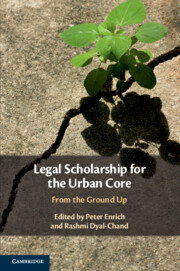Book contents
- Legal Scholarship for the Urban Core
- Legal Scholarship for the Urban Core
- Copyright page
- Contents
- Editors and Contributors
- 1 Introduction
- Part I Change on the Ground
- 2 The Drive for Economic Justice at America’s Port
- 3 Making Good on the “Primacy of Labor”
- Part II Reimagining Law for the Urban Core
- Part III The Legal Academy and the Urban Core
- Index
3 - Making Good on the “Primacy of Labor”
A Case Study of Democratic Participation in a Pioneering American Cooperative
from Part I - Change on the Ground
Published online by Cambridge University Press: 22 June 2019
- Legal Scholarship for the Urban Core
- Legal Scholarship for the Urban Core
- Copyright page
- Contents
- Editors and Contributors
- 1 Introduction
- Part I Change on the Ground
- 2 The Drive for Economic Justice at America’s Port
- 3 Making Good on the “Primacy of Labor”
- Part II Reimagining Law for the Urban Core
- Part III The Legal Academy and the Urban Core
- Index
Summary
The worker cooperative presents a conundrum for community economic development. In theory, it is a business form that seems to match perfectly the ideals and goals of CED. It is one in which workers are the owners – the shareholders – of the business.1 By placing workers at the top of the hierarchical structure of a business, the worker cooperative ought to serve as a powerful vehicle for empowering individuals in the urban core to control their own access to market participation.2 Moreover, by reserving for worker-owners the surplus profit of a business, the cooperative should be an efficient mechanism for poverty alleviation.3 The key to accomplishing these goals is democratic participation by the workers in the business: The workers own and control the business and consequently their economic destiny. However, the sheer paucity of worker cooperatives in the urban cores signals the difficulty of converting theory to practice.4 For reasons that remain under-analyzed, and thus elusive, worker cooperatives are relatively uncommon in American urban cores. Those that do exist typically are small and undercapitalized. Repeated attempts to grow and replicate them have generally foundered.5
- Type
- Chapter
- Information
- Legal Scholarship for the Urban CoreFrom the Ground Up, pp. 60 - 86Publisher: Cambridge University PressPrint publication year: 2019

